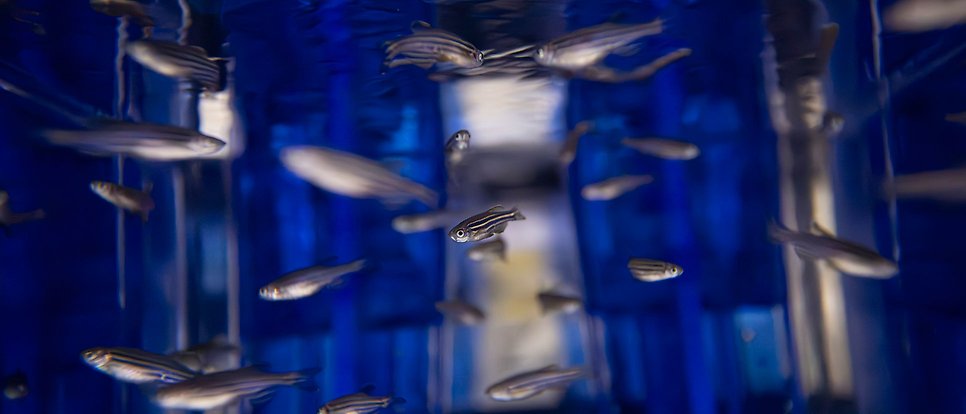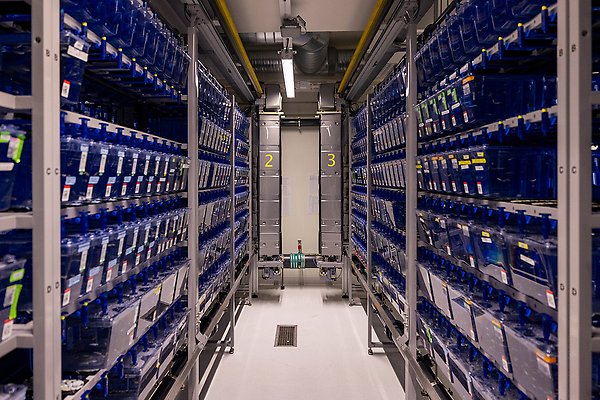Zebrafish research comes together at Uppsala Biomedical Centre

Research on everything from movement patterns to cancer and toxins is conducted here. Zebrafish have become an increasingly popular “model animal” in research as an alternative to rodents. Photo: Mikael Wallerstedt
A state-of-the-art zebrafish facility was recently inaugurated at Uppsala University’s Uppsala Biomedical Centre. It houses around 80,000 zebrafish that are cared for using fully automated methods – all to create an optimal environment for both fish and researchers.
Before we can enter the facility, we need to put on lab coats and wash our hands. The room we enter is clean and sterile. A total of 1,800 tanks are lined up in two rows, with 30–40 fish in each tank.
“There are more than 70,0000 fish in total,” states Joakim Holmdahl, Director of the Centre for In Vivo at Uppsala University.

Joakim Holmdahl, Director of the Centre for In Vivo at Uppsala University. Photo: Mikael Wallerstedt
The facility is ranked as one of the most modern in Europe and complies with current regulations on animal experimentation. A robot moves back and forth along the rows of fish tanks. Feeding of the fish is fully automated.
“All of the fish in here are fed by robots. If a human were to feed them, it might be twice a day, but that is not optimal for the fish. The fish have a good sense of satiety and want to eat many times a day. The fish also like live food that they can hunt,” says Joakim Holmdahl.
Read the code on the tank
The robots read the code on each tank, which indicates the type of food that should be used to feed the fish. Two different types of algae are grown in another room.
Each tank is also labelled with a colour code showing which research leader the fish belong to and a formula indicating the genetic make-up of the fish.

A robot moves back and forth along the rows of fish tanks. Feeding of the fish is fully automated. Photo: Mikael Wallerstedt
Research on everything from movement patterns to cancer and toxins is conducted here. Zebrafish have become an increasingly popular “model animal” in research as an alternative to rodents.
“A large proportion of human genes can be identified in fish. The systems that develop in fish are often more rudimentary, but the research results can be transferred to higher mammals,” says Joakim Holmdahl.
“Zebrafish are in many ways a good alternative to other mammals, including from an ethical perspective.”
Rooms with microscopes
In addition to all the aquariums, there are also rooms with microscopes and lab equipment. The aim of the state-of-the-art facility, where 10 percent of the water is replaced daily and carefully monitored, is to standardise research and make it possible to reproduce (repeat).
The benefits to research were emphasised by Vice-Chancellor Anders Hagfeldt at the inauguration:
“Our hope is that this will lead to the very best conditions in a wide range of disciplines. It is a joint effort within science/technology and medicine/pharmacy that involves both the work environment and animal welfare.”

Kaska Koltowska, a group leader at Immunology, Genetics and Pathology (IGP), researches lymphoedema. Photo: Mikael Wallerstedt
One of the researchers using the new facility is Kaska Koltowska, a group leader at Immunology, Genetics and Pathology (IGP). She researches lymphoedema, lymphatic vessels and blood vessels, mainly by studying embryos. By staining proteins, for example red and green, researchers can follow the development of lymphatic and blood vessels.
“The genetic development of zebrafish is similar to what happens in humans. 80 percent of the genetic diseases in humans can also be studied in zebrafish, such as lymphoedema. Five or six human genes have been shown to cause lymphoedema in fish. One of the genes was even discovered in zebrafish, so there is great potential here,” says Kaska Koltowska.
Facts about the zebrafish facility
- The facility has been built with the latest technology to not only comply with regulations, but also provide a good environment for humans and fish.
- It consists of a central system that holds 1,800 tanks, the largest of which holds 8 litres. Feeding is fully digitalised and carried out by robots. Production of live fish food takes place directly in the facility.
- Zebrafish can be used to study fish behaviour, as well as complex systems or diseases such as gait or diabetes.
- The use of zebrafish is a method suitable for in vivo imaging (which means looking at the live fish with different imaging methods), for toxicological and cancer studies, and more.
